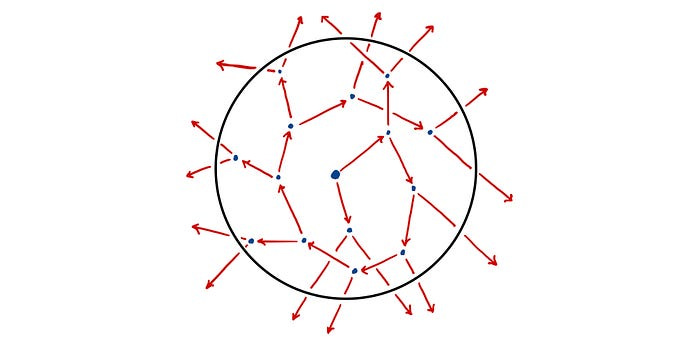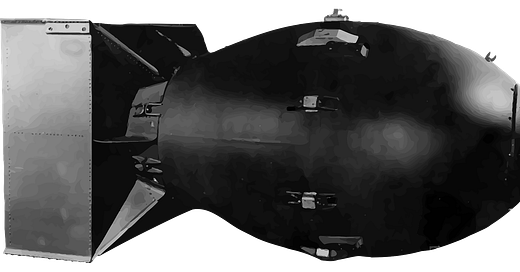Unearthed nuclear-weapons records reignite the feasibility debate
A hoax of astronomical proportions is now conceivable
When hearing of the detonation of a nuclear weapon at Hiroshima in August, 1945, Werner Heisenberg, of Heisenberg Uncertainty Principle fame, is said to have scoffed1:
Some dilettante in America who knows very little about it has bluffed them. I don’t believe that [the bombing of Hiroshima] has anything to do with Uranium.
Heisenberg’s “back of the envelope” calculation had led him to believe that nuclear weapons were infeasible due to the excessive critical mass needed to achieve an uncontrolled nuclear chain reaction of that magnitude.
The skepticism of Heisenberg towards the feasibility of nuclear weapons has been a small footnote in history. That is beginning to change with two recent revelations.
The first revelation was in the book Hiroshima Revisited published by Michael Palmer on October 22, 2022. The book revisits the historical record of studies done in the aftermath of the bombings of Hiroshima and Nagasaki. Most notably, the publication found that the pattern of destruction seen in the aftermath of the bombings of Hiroshima and Nagasaki was similar with that observed in the aftermath of the bombings of other Japanese cities.
For example, this is seen in the words of one observer, Alexander P. de Seversky:
I was keyed up for my first view of an atom-bombed city, prepared for the radically new sights suggested by the exciting descriptions I had read and heard. But to my utter astonishment, Hiroshima from the air looked exactly like all the other burned-out cities I had observed!
The second revelation was the observation by Marc Andreessen on the November 26 Joe Rogan podcast. In that podcast, Andreessen gave evidence that movie recordings of the first nuclear test, code named Trinity, were fabricated.
With these recent questions arising about the evidence for the existence of nuclear weapons, it is worth taking a closer look at one aspect of the design of nuclear weapons: critical mass.
All researchers agree that nuclear material such as Uranium-235 will spontaneously undergo a self-sustaining chain reaction if present in a sufficient quantity and density. There is less agreement, however, on the minimum mass of nuclear material necessary to achieve an explosive nuclear chain reaction. Heisenberg concluded that nuclear weapons were infeasible because the critical mass of a weapon based on Uranium 235 was excessive. According to his calculations, such a bomb would require 13,000 kilograms of Uranium 235.
Heisenberg’s “back of the envelope” estimate is reviewed below in an effort to broaden the discussion of the extraordinary possibility that nuclear weapons do not exist; that nuclear weapons are just another figment of the imagination of the fraudulent scientific apparatus of the United States government.

Simply put, Heisenberg modeled a nuclear chain reaction as a “random walk” in which the cascade of neutrons released in the chain reaction travel in straight lines until they meet with an atomic nucleus at which point the neutron continues moving but in a new random direction. The random-walk model of an explosive nuclear chain reaction is described in “How a Small Miscalculation Stopped Germany From Developing the Atomic Bomb in WWII”. The principle elements of the model are summarized below.
The critical mass of a nuclear material is dependent on the energy released in the nuclear explosion.
The critical mass of uranium-235, for example, is defined as the minimum mass required such that a nuclear chain reaction produces a condition where the total energy of the free neutrons within the fissile material is equal the explosion energy.
The maximum number of free neutrons within the explosive occurs when, for each free neutron within the explosive material, the probability to exit before undergoing a reaction with a uranium-235 nucleus is exactly 50%.
The maximum number of free neutrons within the explosive can be estimated with a random-walk model. The model incorporates the “mean free path” of the neutron that is the average distance that a neutron travels from its creation in the fission of one uranium-235 nucleus until its reaction with a second Uranium-235 nucleus.
The nuclear chain reaction is modeled as a random walk where a neutron is considered to bounce in a random direction after each collision/reaction with a uranium-235 nucleus.
At each iteration of the nuclear chain reaction, all of the daughter neutrons are at an identical phase of a random walk and thus have an identical probability of exiting from the explosive.
The random-walk model provides an estimate of the time at which each neutron has a 50% probability of exiting from the explosive.
This model has been rejected by others. However, given the growing doubts about the evidence of nuclear weapons, the question of the feasibility of nuclear weapons needs to be given serious reconsideration including the above-discussed model of Heisenberg.
UPDATE 12-31-14
Here are a couple of links related to the author of Hiroshima Revisited.
Upon receiving further descriptions of the bombing of Hiroshima and Nagasaki, Heisenberg is said to have accepted that nuclear weapons were detonated over both cities.





Between the fake moon landing in 69, buildings diving into there own footprint from jet fuel and the 100% preplanned fake pandemic, I'm now ready to consider anything including fake A bombs
I'm intrigued by the possibility that nuclear weapons don't exist but what about those famous photos of giant mushroom clouds over vaporized Pacific islands?